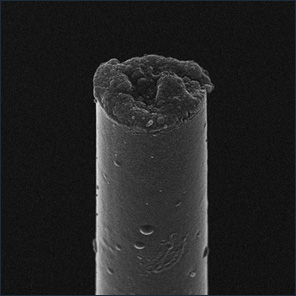Scientists from University of Pittsburgh developed the implanted neural interface which can be connected directly to separate neurons
The technology is based on the superthin carbon fiber covered with chemicals, protecting the neurointerface from rejection by a brain of the person.
The tiny thread about 7 microns in the diameter can be connected to separate neuron. In the long term the similar neurointerface will allow to combine electronic devices directly with nervous system of the person. And level of separate neurons assumes actually unlimited opportunities: from "revival" of the paralyzed extremities, before management of difficult cars which in literal sense become continuation of a human body.

Tiny carbon fiber in the long term will allow to connect people to electronic devices
Scientists want to create the neurointerface capable without problems to fulfill in a body of the person throughout 70 years. For this purpose it is necessary to pick up a material, decades keeping functionality and not torn away by immune system. For the solution of this problem the American scientists made the complex composite electrode consisting of the carbon fiber core, a thin-film covering of poly-steam - ксилилена and poly-тиофена. As a result it was succeeded to create an implant, much smaller, than modern electrodes for record of neural activity. Moreover, the new interface is better compatible to brain fabric: causes less mechanical damages and immune reactions.
Now tests of the new neurointerface on rats are conducted. Experiments already show prospects of technology, in particular it isn't observed any long-term changes of nervous fabric and degradation of implants. Also the neurointerface allows to read out signals with unsurpassed selectivity that is very important for, for example, high-precision management of artificial limbs.
Hi,
ReplyDeleteI was wondering what the source for this was. Could you tell me the name of the paper is that this was reported in, or the name of the professor at University of Pittsburgh who was the head of this project?
Thanks,
Chris